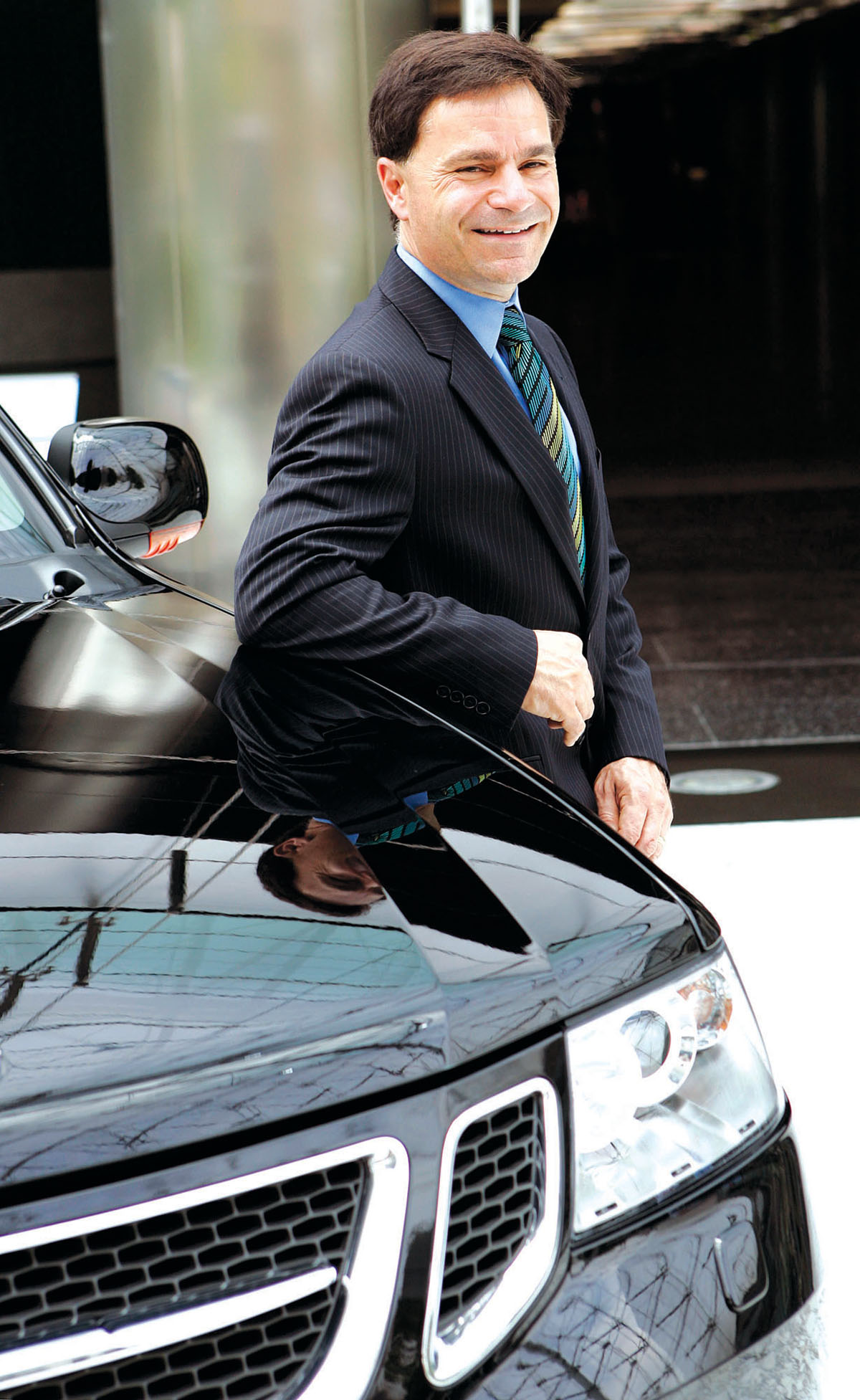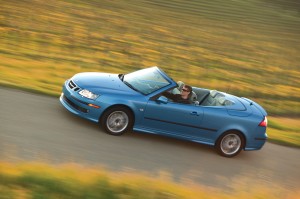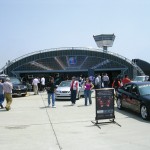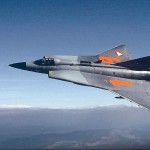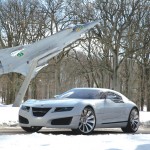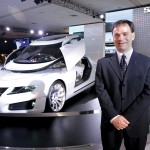By S. Clayton Moore
Revitalizing a company is one thing. Remaking it is another.
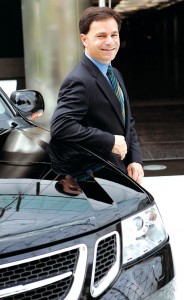
Jay Spenchian, the new general manager of Saab, has been responsible for guiding the company’s successful “Born From Jets” campaign.
Try jump-starting the once lackluster Cadillac brand of automobiles. Who on earth would imagine boosting the company’s supercharged lineup of newly designed automobiles, complete with a soundtrack by Led Zeppelin? That was the job Jay G. Spenchian held at Cadillac, where the marketing guru was responsible for launching a string of Cadillacs that have proven to be wildly successful.
So what do you do for an encore? If you’re Spenchian, you take on the only automobile brand in the world that was born from jets: Saab Automobile. Saab’s new general manager is a rising star in the fast-paced world of the auto industry.
The new guy
Before he joined the automobile world, Spenchian held top product management and marketing positions at The Pillsbury Company, Pepsi, Heinz and Sara Lee. But he really jumped into the auto world with both feet when he joined General Motors as a marketing director in 1998.
At Cadillac, Spenchian was tenacious, launching a string of new products including Cadillac’s Escalade, CTS, SRX, XLR and STS, all backed with a spirited marketing campaign that reinvented the company for the new century.
“At Cadillac, our challenge was to turn around some perceptions that had become dated,” Spenchian recalled. “There were all these old stereotypes that Cadillacs were big, floating boats. We always said that if we’d been dealing with the old cars, we couldn’t have matched them to Led Zeppelin. It was only when the products began changing that you could utilize rock n’ roll.”
In 2000, General Motors completed its purchase of Saab Automobile, which had taken nearly a decade to complete. The move allowed GM to capitalize on the boundless imagination of Saab engineers and delve into the brand’s heritage but also allowed Saab to leverage GM’s enormous marketing and manufacturing resources.
Spenchian, 47, became general manager of Saab Automobile USA in April 2005. He took time during the early days of his tenure walking factory floors, talking to employees and dealers, and learning what makes Saab great.
“Right after I got here, we started doing research,” Spenchian said. “When Saab was at its best, what were we doing right? If you look back at the 1980s, the black turbo was the iconic image of Saab, because there was nothing else like it. It’s unique design, Scandinavian in nature, with a combination of turbocharged performance, safety and fuel economy. That’s what makes a Saab a Saab.”
There are some similarities between Cadillac and Saab, although Spenchian says both are in different starting positions.
“The main difference is that Saab is a much smaller brand from the standpoint of size,” he explained. “But both are what we call ‘high conquest brands,’ meaning the majority of sales volume comes in from people who haven’t driven a GM vehicle before, which is very good. You get a lot of new buyers that other brands in the GM portfolio might not be able to attract. At the same time, Cadillac has already experienced an expansion of their product portfolio and is reaping the benefit from a sales standpoint, where we’re just now starting to expand.”
During its heyday, Saab was an enormously successful company, with nearly five years of consecutive sales increases in the 1980s. But the company’s reputation had suffered in recent years. Fortunately, Spenchian has been able to raise the company’s profile during his short time at Saab and prove the brand’s potential to employees, customers and General Motors.
“The state of Saab today in terms of GM’s commitment to Saab and the support that we get from everyone here is outstanding, but that was definitely in question when I took over,” Spenchian admitted.
What the company seems to have needed is one good idea.
“Our task was to take the DNA of Saab and make it relevant today,” Spenchian said. “What’s a good way to express that fundamental idea for customers?”
“Born From Jets”
The answer to Saab’s dilemma wasn’t a new idea, but an old one. Under Spenchian’s guidance, Saab introduced the most comprehensive advertising campaign in its history. It’s one that draws not only on Saab’s future but also on its vibrant past.
First, a history lesson. The company now known as Saab actually started life as Svenska Aeroplan AB, a Swedish manufacturer founded in 1937. Based in the town of Trollhätten, the company was best known for designing aircraft for the Swedish Air Force.
In 1947, a team of 16 aeronautical engineers broke off to build the Saab 92, the first automobile built by the burgeoning car company. The 92’s streamline, teardrop-shaped bodywork was clearly the work of aviation-oriented minds and was radical for a small production car of its time.

It’s not all hard work: Jay Spenchian meets with model Petra Nemcova at the New York International Auto Show.
American audiences were introduced to Saab in 1956 at the New York Auto Show, where the company showcased the Saab 93, a sturdy automobile with a 33-hp, three-cylinder engine. Soon after, the company debuted the Sonnet 1, a lightweight sports car made from aviation-quality aluminum that later inspired designs for Grand Prix racing.
It was that aviation-based heritage that Saab brought to bear in a unique concept created by London-based agency Lowe Worldwide. The fully integrated campaign, “Born From Jets,” conveys Saab’s aviation legacy across a range of media including print, national television, radio, outdoor visuals and nationwide promotional activities.
“We kept coming back to our aircraft heritage, which really explains why Saabs are the way they are today,” Spenchian said. “The safety, performance and especially design all go back to Saab’s aviation roots. It was a very emotional way of sharing Saab’s core ideas with customers.”
Spenchian says the best thing about the campaign is its universal appeal.
“The challenge of getting any brand back to success is drawing in new customers without alienating the core franchise,” he explained. “The great thing about Saab’s aviation heritage is that the loyalists love it and the conquest customers who might not normally consider Saab love it, too. It’s unique and no one else can really say it. It gives us a cool factor that we might not have otherwise had.”
All the associations between aviation and Saab’s high-tech automobiles have brought Saab new customers.
“Whether you’re older or younger, there’s always an interest in aviation for people,” Spenchian said. “That’s what we loved about this idea. You get safety, performance, fast, fun and high-tech all wrapped up in the same message but also with a lot of very rich imagery. People have a passion for automobiles as well as a passion for airplanes. Americans, for the most part, buy with their hearts, and that’s what we’re trying to capture.”
“Born From Jets” allows Saab to communicate a genuine message about automotive engineering in a media-saturated era when the very word “performance” may have lost its meaning for consumers.
“Performance is a very broad term,” Spenchian observed. “For some, it’s zero-to-sixty. For some, it’s passing and acceleration. It really depends. Saab is not just about performance. It’s about the balance of a lot of different elements that make our products unique. I think with this campaign, we can package that idea up tightly and people get it.”
The campaign is tied in with Saab’s most aggressive product development program in its 60-year history. In the past few years alone, the company has launched the 9-7X, Saab’s first-ever sport utility vehicle, and the 250-hp Turbo Aero, which has the first V6 engine in the company’s history. It also rebuilt the 9-5 sedan and freshened the interior of the 9-3 line.
“The more the new cars match up with the campaign, the truer they are to what Saab really is,” Spenchian said. “The 9-3 convertible really matches up well; it’s our iconic, lead image. That automobile really has a lot of the aircraft heritage and Scandinavian design in it.”
To carry their message out to both the general aviation community and the general public, Saab has taken “Born From Jets” on tour.
On the road again
Saab is coming to America’s biggest air shows and it’s a lot more than just setting up a booth.
Saab designed a touring display that could be mistaken for an aircraft hangar. The mobile unit features technical displays and plasma screens showing the dynamic “Born From Jets” commercials and other demonstrative videos. Visitors can take a test drive and pepper Saab’s product specialists with questions about the vehicles.
Saab has already had great reaction to its events in Washington, New York and Boston. The company will be featuring its “Born From Jets” tour during upcoming events at the Chicago Air & Water Show August 19-20, the Cleveland Air Show September 2-4, and during Fleet Week in San Francisco October 6-8, as well as through several Saab Business Aircraft & Jet Previews organized by Airport Journals.
“We’ve had a number of these events around the country where we’ve been able to showcase the vehicles,” Spenchian said. “It’s a low-key sell on Saab, but it provides a very high-tech look at what we have to offer. The nice thing about people having a slightly lower awareness of our vehicles is that when they are on display, it’s pretty powerful for them. We need to be in more places like these where people might not expect Saab.”
Some events feature a demonstration by the Saab Performance Team, the driving team founded in 1987 in honor of the automaker’s 40th anniversary. It features real Saab engineers engaged in an incredible display of driving skill.
“Sometimes I wish they didn’t hold regular jobs at Saab so we could use them more,” Spenchian laughed. “They’re in very high demand for a reason. The impression that this performance team leaves with people when they see it live and in person changes the game. The driving dynamics are absolutely extraordinary and not just any vehicle could pull off the types of moves that they do.”
The “wheelie specialists” on the team take Saab’s automobiles on quite a ride, tipping them up on two wheels or racing through a breathless display of precision acceleration and braking.
“In many ways, seeing the performance team is better than a test drive might be,” Spenchian observed. “You have professionals performing in a way that people could never drive on their own. The precision necessary to drive that way makes a big impact.”
Some buyers can get a similar experience at Saab’s Aero Academy, a two-day performance-driving event held at Road Atlanta in Braselton, Ga., one of the world’s premier race tracks. Available exclusively to new buyers of selected Saabs, the driving school combines classroom training with advanced handling exercises on specially constructed training tracks.
One model that buyers can’t get their hands on yet proves once and for all that Saab is here to stay: the Aero X.
“A jet on wheels”
Sales are up at Saab by more than five percent as of the latest numbers—well above the industry average. Ironically, Saab and Hummer are the two brands that are up this year in the General Motors portfolio.
One major demonstration of GM’s commitment to the brand is the millions of dollars poured into Saab’s latest concept car, the Aero X, unveiled at the Geneva International Auto Show in March.
Featuring a cockpit canopy, a 400-hp, twin-turbo V6 engine fueled by ethanol and precision instruments that echo the state-of-the-art avionics in very light jets, the carbon fiber Aero X is a firm example of Saab’s decision to capitalize on its aviation heritage.
“It’s a jet on wheels,” Spenchian said. “People are saying that it’s ‘Born From Jets’ come to life. It created its own buzz simply through the way it looks.”
Spenchian also affirmed that the ideas inherent in the vehicle will make their way to future production cars.
“The whole idea and the emotional intent in the Aero X are certainly going to be there in our automobiles,” Spenchian said. “It’s a unique look that no one can replicate, and that’s a good direction to take. We’re not a mainstream product lineup. We’re a niche product lineup. We believe that we don’t have to appeal to the masses, so we can take a little bit of risk in moving that design forward to the point where it may not be for everyone. But, the people who like it are really going to like it, which is the case with the Aero X.”
The event was the culmination of a dramatic few months for both Saab and GM. In January, a key advisor to Nevada billionaire Kirk Kerkorian, one of GM’s largest investors, called for GM to dump both Hummer and Saab. But GM decided to commit to the brand.
Carl-Peter Forster, president of General Motors’ European division, said in February that GM had definitively chosen to stay the course with Saab and defended its future. Kerkorian has since reversed his position.
“I have to say that a company who doesn’t believe in a brand’s future wouldn’t make the kind of investment that we spent in developing the Aero X,” Spenchian said. “Nor would GM take that opportunity at the Geneva Auto Show to select a single brand and put it up on a pedestal. Any question about the future of Saab is over.”
GM and Saab bring advantages to each other, according to Spenchian.
“Having GM on our side allows us to compete globally,” he said. “The investment into our future product portfolio is where GM’s contributions really manifest themselves most clearly. We also bring a portfolio of customers who are very affluent and well-educated. It’s a nice balance and a very complementary relationship.”
Racing towards the future
The company has ambitious plans for the future, but Spenchian’s biggest concern right now is getting the “Born From Jets” message out to customers.
“My job is to figure out how to get Saab on the radar—no pun intended—and get more people interested in Saab,” he said. “People weren’t always sure why we were different. Now we’re telling them why. It’s because of this aircraft inspiration.”
The response to the campaign from both consumers and Saab’s extensive dealer network has been positive. The company’s research indicates that Saab dealers are rated second highest in satisfaction with the marketing, behind Hummer.
“The customer reaction has been outstanding, but the reaction from potential customers has been even stronger,” Spenchian said. “Every measure that we look at has doubled compared to our previous marketing campaign. It makes people want to learn more, makes them more interested, and most importantly, makes them want to drive a Saab.”
Saab recently demonstrated its commitment to general aviation with its support of Angel Flight America. The company has given substantial financial assistance to the nonprofit organization, which provides air transport services to patients in need, as well as tying its marketing campaign to Angel Flight. Saab has also donated several of its 9-7X SUVs to a volunteer companion group, Earth Angels.
“It’s a good tie-in with a good cause that we feel is in keeping with our aviation heritage,” Spenchian said. “It’s a good story and it touches your heart. If there’s a way for us to raise awareness of the work these good people do through our association with them, we’re more than happy to help.”
Although product development cycles are shrinking, Saab products have traditionally had long life cycles. To keep attracting buyers, staying consistent with this new marketing campaign is essential.
“We’re very committed to the marketing,” Spenchian said. “Those with long memories recall that at various points in its history, Saab has touched on this heritage but always walked away from it for some reason. It resonates well and we’re staying with it. With our long life cycles, we’ve just scratched the surface. People might not be in the market for three or four years so they may not be paying close attention just yet.”
Despite the dramatic and aggressive changes in its product portfolio, there are more to come, according to Spenchian.
“We’re shortening up our life cycles considerably,” he said. “I think we’re in the right market segments, but we’re not exactly where we need to be in the long run. The challenge is to continue to innovate and change the portfolio. The evolution isn’t over yet, but we’re making some inroads. I’m pleased with our progress so far.”
But it’s not just about future vehicles at Saab. Spenchian has a very positive outlook on the current portfolio of vehicles.
“I remind our employees and dealers that the lineup we have is excellent,” he said. “We need to do some innovative things to create awareness about what we have today and not bank on it all being about the future. We believe that long term, it’s not just the products but also the ownership experience that sets us apart from other brands.”
Spenchian is well-supported in his efforts, both by GM’s management and his own team.
“I have a great team here,” he said. “It’s a combination of people from Saab and people who have come from other GM brands. We have a sales force that combines Saab’s history and new, innovative ideas. We have a great dealer network that has helped me to understand what makes a Saab a Saab. With all these great people around me, my learning curve has been much easier.”
So how does the general manager of Saab travel? Well, General Motors maintains a few Gulfstream GVs, but his usual mode of transport is an electric blue version of Saab’s new “20 Year Anniversary Edition” 9-3 Aero, a very cool turbocharged convertible.
“Driving one brings a smile to your face,” Spenchian said. “You can, with a lot of confidence, tell your friends and family that they ought to be driving one of these vehicles. That’s the way we all feel at Saab.”
For more from Saab, visit www.saabusa.com. For more about “Born From Jets,” visit [http://www.bornfromjets.com]. Saab’s 2006 events are online at [http://www2.saabusa.com/events/]. To help Angel Flight America, visit [http://www.angelflightamerica.org].
- To bring its message to aviators and the public, Saab developed the “Born From Jets” tour, a high-tech display highlighting its vehicles.
- Saab Automobile is now a separately owned division of General Motors, but its engineers still draw inspiration from the Swedish company’s aircraft, like this Draken jet.
- Saab’s devotion to aviation design is most apparent in the Aero X concept car, seen here with an original Saab 35H Draken aircraft.
- Saab Automobile’s engineers are chasing the elusive cool factor inherent in jets like these Swedish Saab-built JAS 39 Gripen fighters, seen here refueling air-to-air with a C-130.
- At the New York International Auto Show in April, Jay Spenchian showed off Saab’s innovative Aero X concept car.











